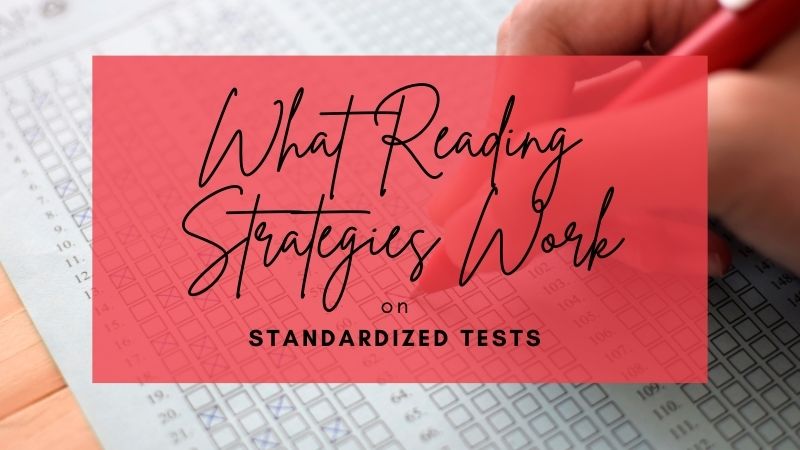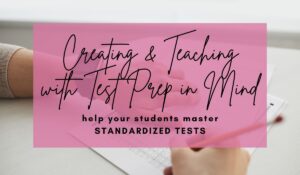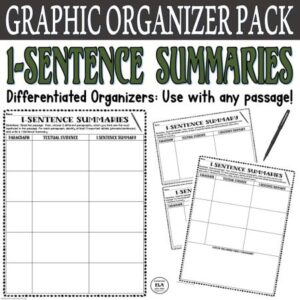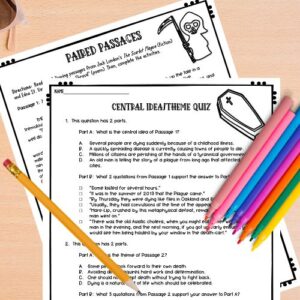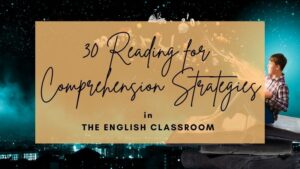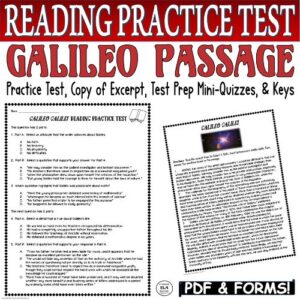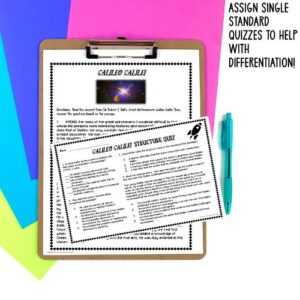Let’s be real. Standardized testing is here to stay, at least for a while anyway. We cannot escape standardized tests, especially if we are ELA and/or Reading Teachers. Now, I know we all are thinking the following: What reading strategies can we realistically provide to our students that are vital to their success on these high-stakes tests?
What reading strategies work for me? Well, in my own classroom, I try to avoid long lists or complicated ideas. And so often, I have seen students make progress with a couple of tweaks to how they approach testing.
Keep reading to find out what reading strategies your students can EASILY and READILY use in ANY reading test situation!
Need help with teaching what reading strategies will work while using Test Prep? Check out this FREE Pack of 3 Test Prep Activities to help students achieve success on standardized tests!

What Reading Strategies Work on Standardized Tests
1. If you have the time, read each passage.
Too often, people recommend simply skimming a text when reviewing what reading strategies to use on standardized tests. Unfortunately, most students cannot skim or scan well. It takes a couple of moments of actually reading a paragraph or two to understand what a passage is actually talking about. This issue is why you need to be careful with what reading strategies you teach or others teach throughout the year.
If the passage is a narrative story or makes an argument, the concept of skimming makes comprehension even more difficult. An argument’s topic may be presented in the introduction, but many times it is not. Instead, writers may begin with an anecdote, or very short story, to introduce the argument’s ideas. Likewise, a narrative may not even get to the plot until several paragraphs in. A setting may be described or a character might be depicted.
Clearly, a quick scan will yield little help on a standardized test.
Now, if you are at the last passage, and you only have five minutes left, feel free to skim or scan. Then, do your best to answer the questions based on what you know and what reading strategies you learn here!
2. Annotate and/or underline as you read.
What reading strategies am I the most fond of? Well, I am a huge fan of annotating (writing down a quick note in a word or phrase) while reading. It keeps you actively engaged while reading if you write something, sometimes anything about the passage. It doesn’t have to take a long time.
Making Annotations
Let’s take a look at this paragraph about Galileo:
1 AMONG the ranks of the great astronomers it would be difficult to find one whose life presents more interesting features and remarkable changes than does that of Galileo. We may consider him as the patient investigator and brilliant discoverer. We may consider him in his private relationships, especially to his daughter, Sister Maria Celeste, a woman of very remarkable character; and we have also the pathetic drama at the close of Galileo’s life, when the philosopher drew down upon himself the criticism of the Inquisition.
Annotation Ideas:
- Ex. Galileo, astronomer, interesting life
- Ex. Galileo was an important person both personally and professionally.
Here is the next paragraph about Galileo:
2 The materials for the biography of this astonishing man are sufficiently abundant. We make special use in this place of those charming letters which his daughter wrote to him from her convent home. More than a hundred of these have been preserved, and it may well be doubted whether any more beautiful and touching series of letters addressed to a parent by a dearly loved child have ever been written. An admirable account of this correspondence is contained in a little book entitled “The Private Life of Galileo,” published anonymously by Messrs. Macmillan in 1870, and I have been much indebted to the author of that volume for many of the facts contained in this chapter.
Annotation Ideas:
- Ex. Info about Galileo from books and daughter’s letters
- Ex. The author is grateful for biographical materials from various sources.
As you can see, I am writing down related concepts from paragraph to paragraph. That is the goal. Students need to see the connective thread throughout the passage in order to understand the main ideas presented within. What reading strategies have you found to help with annotating?
Underlining
Please, please, please…don’t underline everything you think is important or tell your students to do so. They will underline or highlight the entire passage or nothing at all. It takes discernment and skill to know what is truly important in a passage.
Instead, you might have your students underline the sentence that BEST SUMMARIZES the paragraph or ideas that are repeated.
Check out the 3rd paragraph about Galileo:
3 Galileo was born at Pisa, on 18th February 1564. He was the eldest son of Vincenzo de Bonajuti de Galilei, a Florentine noble. Notwithstanding his memorable birth and descent, it would seem that the home in which the great philosopher’s childhood was spent was an impoverished one. It was obvious at least that the young Galileo would have to be provided with some employment by which he might earn an income. From his father he inherited a keen taste for music, and it appears that he became an excellent performer on the lute. He was also gifted with considerable artistic power, which he developed diligently. Indeed, it would seem that for some time the future astronomer entertained the idea of devoting himself to painting as a profession. His father, however, decided that he should study medicine. Accordingly, we find that when Galileo was seventeen years of age and had added a knowledge of Greek and Latin to his familiarity with the fine arts, he was duly entered at the University of Pisa.
I would probably underline this sentence as a part of what reading strategies I would encourage:
Accordingly, we find that when Galileo was seventeen years of age and had added a knowledge of Greek and Latin to his familiarity with the fine arts, he was duly entered at the University of Pisa.
Here is why: it includes a connection to his education, how he grew up, and the inclusion of fine arts. There is no perfect answer; the goal is to get students to think about WHY they might choose a specific sentence.
Do your students need more practice with reading comprehension and what reading strategies to use? Check out the post below!
3. Summarize the passage to include the topic and purpose/meaning before looking at the questions.
Standardized tests are trying to trick you. They have a right answer, mostly right answers, sort of right/wrong answers, or really wrong answers. It is the nature of the beast, unfortunately.
So, if your students can summarize the passage before they even read the questions, it might help them as they answer the questions.
Topic: Galileo’s Life
Purpose/Meaning: Explain how important events contributed to Galileo’s life.
Click HERE or below to get DIFFERENTIATED organizers to help your students with summarizing!
4. Answer the questions (mentally) before looking at the answers.
Here is a sample question about tone:
#1. Based on the following quotation, what is the speaker’s tone? “AMONG the ranks of the great astronomers it would be difficult to find one whose life presents more interesting features and remarkable changes than does that of Galileo.”
The tone is the emotion relayed by the author about the topic/meaning in the excerpt.
Well, we have words like “interesting,” “great,” and “remarkable” to describe the astronomer, Galileo. These words are obviously positive in connotation as no sarcasm is evident. So now, we know the tone word would connect to something like “admiring” or “appreciative.”
This simple technique of reading and trying to answer before checking out the answers will help tremendously!
5. Read ALL of the answers in DCBA order.
My hubby used this strategy with his struggling readers because he noticed something very important. Many times students will read the first two answers and choose one because it looks good. Encourage students to read all of the answers in this order, so they can see their options.
Let’s work on this question from the Galileo Test Prep Practice Quiz Pack:
Based on the following quotation, what is the speaker’s tone?
“Galileo was born at Pisa, on 18th February 1564. He was the eldest son of Vincenzo de Bonajuti de Galilei, a Florentine noble.”
A. Exasperated
B. Passionate
C. Adoring
D. Neutral
If students don’t know the meaning of “exasperated,” they might choose this answer because, in their minds, it sounds good. If they had just kept reading ALL of the options, they would see “neutral” as the clear correct answer. The information relayed is merely factual, so the tone is “neutral.”
Do your students need help with determining the central idea, examining the theme, and citing evidence while using what reading strategies you learned about in this post? Click HERE to get this ready-made pack!
6. Eliminate wrong answers but have a reason for doing so.
Elimination is a tool I use all of the time. On a typical reading test, you might have 4 or 5 answer options. By eliminating 2 incorrect answers out of 4, you now have a 50% chance of getting the answer right.
If you go back and reread the passage for certain questions, you will stand an even better chance of eliminating obviously wrong answers.
Have a reason for eliminating every wrong answer; don’t just guess.
7. Use all of your time.
I have administered standardized tests for over 15 years. It never ceases to amaze me that students are done with ten, twenty, and even thirty minutes to spare. And when you look around, typically my students who are higher-level readers and writers use all or MOST of their time. This strategy is probably the most important when it comes to deciding on what reading strategies you implement.
What reading strategies they spend their last minutes on:
- Checking their answers for correctness. After answering other questions about a passage, your previous responses might change based on increased comprehension.
- Making sure their answers are in order. Sometimes students will skip a question but forget to skip the bubble on the answer sheet.
- Answering all of the questions for certain tests. With some tests, there is no penalty for wrong answers. If I have five questions left, I usually choose one letter and go all the way down.
- Adding to written responses. Quantity does not equal quality; however, you cannot have quality without some quantity.
Ultimately, what reading strategies you choose is up to you. Giving students a choice will help as well. Practicing with 3 or more of these strategies will result in tremendous growth!

Want 30 Reading Comprehension Strategies you can use in your classroom today? Click HERE to read about this vital topic for Reading and English teachers!
What reading strategies should you avoid during standardized testing?
1. Skimming the passages instead of reading
State tests are meant to measure reading comprehension levels. If you don’t read, you will not be able to answer the questions. Out of what reading strategies you find here, I would not forget this point!
And yes, we have all heard the mythical stories of some genius kid who skimmed and got a perfect score. 99.99999% of students are not this genius kid, which is okay. It seems very basic, but reading on a reading test is required. So if someone tells you that not reading and skimming instead is a good reading strategy to use, don’t listen.
2. Skipping the written response questions
These questions are usually worth a lot of points. Students believe they can skip these questions and still pass. Well, they can’t if they are struggling readers. Even a couple of sentences is better than nothing.
Someone might claim that skipping a written response is a good idea, and it might be ONLY IF you come back to answer it. Take a couple of minutes and write something that uses evidence from the passage. Often, if students keep writing, they will normally write their way into some points.
And those points could be the difference between passing and failing, graduating and not graduating, and getting a scholarship and not getting a scholarship.
I get that what reading strategies don’t work for some might work for others; however, points are points.
3. Taking your time
There are few standardized tests that don’t have a time element. Even if you have accommodations, there is usually a limit to the time. Otherwise, it could take weeks to finish a single test. You don’t really want to take your time; you just want to use your time wisely when you choose what reading strategies to use!
If you need thirty seconds to close your eyes and think, go for it. Looking out the window, checking on what others are doing, or watching the proctor walk the room will not help you succeed on the test.
4. Checking out the questions before you read
What reading strategies have you heard time after time? I have heard the above over and over again. Check out the first couple of questions ahead of time as you can keep the questions in your mind while reading the passage. Most of the time this strategy does not help in the slightest as students start searching for the answer instead of reading to comprehend the passage.
Instead, encourage your students to constantly reflect on the main or central idea. What is the author talking about? What is the purpose for writing this passage?
What reading strategies you have found to be successful?
When it comes down to it, you need to decide what reading strategies can work best for your individual students. Who knows? That one tip might be the advantage a student needs to succeed!
Need more ideas for what reading strategies to use for specific texts? Check out my store Kristin Menke-Integrated ELA Test Prep!

